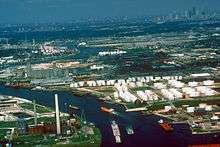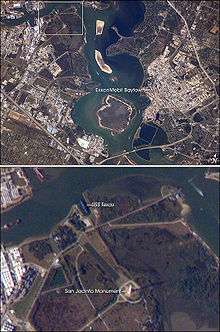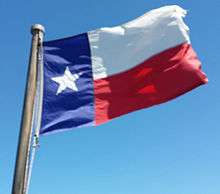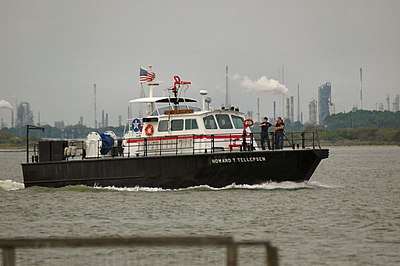Houston Ship Channel
The Houston Ship Channel, in Houston, Texas, is part of the Port of Houston, one of the busiest seaports in the world. The channel is the conduit for ocean-going vessels between Houston-area terminals and the Gulf of Mexico, and it serves an increasing volume of inland barge traffic.

Overview

The channel is a widened and deepened natural watercourse created by dredging Buffalo Bayou and Galveston Bay.[2] The channel's upstream terminus lies about four miles east of downtown Houston, at the Turning Basin, with its downstream terminus at a gateway to the Gulf of Mexico, between Galveston Island and the Bolivar Peninsula.[3] Major products, such as petrochemicals and Midwestern grain, are transported in bulk together with general cargo. The original watercourse for the channel, Buffalo Bayou, has its headwaters 30 miles (48 km) to the west of the city of Houston. The navigational head of the channel, the most upstream point to which general cargo ships can travel, is at Turning Basin in east Houston.[4]
The channel has numerous terminals and berthing locations along Buffalo Bayou and Galveston Bay. The major public terminals include Turning Basin, Barbours Cut, and Bayport. Many private docks are there, as well, including the ExxonMobil Baytown Complex and the Deer Park Complex.[5][6]
The channel, occasionally widened and deepened to accommodate ever-larger ships, is 530 feet (160 m) wide by 45 feet (14 m) deep by 50 miles (80 km) long. The islands in the ship channel are part of the ongoing widening and deepening project. The islands are formed from soil pulled up by dredging, and the salt marshes and bird islands are part of the Houston Port Authority's beneficial use and environmental mitigation responsibilities.
The channel has five vehicle crossings: Washburn Tunnel, Sidney Sherman Bridge, Sam Houston Ship Channel Bridge, popularly known as the Beltway 8 Bridge; Fred Hartman Bridge connecting La Porte and Baytown, Texas; and Lynchburg Ferry.
History

John Richardson Harris platted the town of Harrisburg, Texas on Buffalo Bayou at the mouth of Bray's Bayou in 1826. He established a steam mill there, while making Harrisburg into a logistical center for the Austin Colony. He plied his schooner The Rights of Man through the waters of Galveston Bay and Buffalo Bayou, importing supplies from the United States, and exporting cotton and hides. However, fewer people settled Buffalo Bayou than the fertile Brazos Valley, so Harrisburg remained a remote overland location from the critical mass of farmlands: about 20 miles from Fort Bend, Texas and about 40 miles from San Felipe de Austin, Texas. Travelling the Brazos River presented several hazards, most of all, its shifting, shallow sandbars at its mouth. Despite several interventions, the river remained hostile to navigation.[7] Nicholas Clopper acquired land downstream from Harrisburg, the eponymously named Clopper's Point. He recruited six men from Ohio to work as traders, who sailed the schooner Little Zoe from Cincinnati laden with supplies such as flour and spices, nails and other hardware, and whiskey and tobacco. Two of these hires were his sons, Edward and Joseph Clopper. They recorded their travels in a journal, reporting several hazards of Galveston Bay in route to Buffalo Bayou. They ran Little Zoe aground on Galveston Island and later observed two wrecked ships in the bay. They encountered the shallow Red Fish Bar, which they passed while dragging over it.[8]
The channel has been used to move goods to the sea since at least 1836. Buffalo Bayou and Galveston Bay were dredged during the late 19th and early 20th centuries to accommodate larger ships. In the wake of the 1900 Galveston hurricane, the inland Port of Houston was seen as a safer long-term option, and planning for a larger ship channel began.[9] By the mid 1900s the Port of Houston had established itself as the leading port in Texas, eclipsing the natural harbors at Galveston and Texas City.[10] The Turning Basin terminal in Harrisburg (now part of Houston) became the port's largest shipping point.
On January 10, 1910, residents of Harris County voted 16 to 1 to fund dredging the Houston ship channel to a depth of 25 feet for the amount of $1,250,000, which was then matched by federal funds. On June 14, 1914 the first deepwater ship, steamship Satilla, arrived at the port of Houston, establishing steamboat service between New York City and Houston. On November 10, 1914, President Woodrow Wilson opened the Houston Ship Channel, part of the Port of Houston.[11] The onset of World War I and the first mechanized war's thirst for oil greatly increased use of the ship channel.
The United States Army Corps of Engineers increased the depth of the channel from 25 to 30 feet in 1922.[12]
In 1933, the United States Department of War and the United States House Committee on Rivers and Harbors approved a plan to increase the depth of the channel from 30 to 34 feet and widen the Galveston Bay section from 250 to 400 feet. The Public Works Administration provided $2,800,000 dollars for the project, which was completed in late 1935.[13]
The proximity to Texas oilfields led to the establishment of numerous petrochemical refineries along the waterway, such as the ExxonMobil Baytown installation on the eastern bank of the San Jacinto River. Now the channel and surrounding area support the second-largest petrochemical complex in the world.[14]
While much of the Houston Ship Channel is associated with heavy industry, two icons of Texas history are also located along its length. The USS Texas (BB-35) saw service during both world wars, and is the oldest remaining example of a dreadnought-era battleship in existence.[15] The nearby San Jacinto Monument commemorates the Battle of San Jacinto (1836) in which Texas won its independence from Mexico.
The US Army's San Jacinto Ordnance Depot was located on the channel from 1941–1964.[16]
Currently, the channel is dredged to a depth of 43–45 feet. The channel was designated a National Civil Engineering Landmark by the American Society of Civil Engineers (ASCE) in 1987.[14]
The "Texas chicken" maneuver [17] is known to mariners who regularly navigate large vessels on the Houston Ship Channel. As two vessels approach from opposite directions, both normally turn to starboard to allow water displaced by their bows to move the ships away from each other and from the channel's centerline. After they pass, the suction of the displaced water flowing in behind the ships naturally pulls them back toward the center of the waterway.
Pollution

On December 25, 2007, the Houston Ship Channel was featured on the CNN Special, Planet in Peril, as a potential polluter of nearby neighborhoods. That year, the University of Texas released a study suggesting that children living within 2 miles (3.2 km) of the Houston Ship Channel were 56% more likely to become sick with leukemia than the national average.[18]
On March 22, 2014, a barge carrying nearly a million gallons of marine fuel oil collided with another ship in the Houston Ship Channel, causing the contents of one of the barge's 168,000-gallon tanks to leak into Galveston Bay.[19]
Gallery
 Drawing of ship at port 1859
Drawing of ship at port 1859 Drawing of ship at port 1859
Drawing of ship at port 1859 The Houston Ship Channel during its first opening in 1915
The Houston Ship Channel during its first opening in 1915 Houston Ship Channel and foot of Main Street, Houston, Texas (postcard, circa 1910)
Houston Ship Channel and foot of Main Street, Houston, Texas (postcard, circa 1910) Yachts in the Houston Turning Basin, Houston (postcard, circa 1911)
Yachts in the Houston Turning Basin, Houston (postcard, circa 1911) Ship Turning Basin, Buffalo River, Houston (postcard, circa 1914-1924)
Ship Turning Basin, Buffalo River, Houston (postcard, circa 1914-1924).jpg) Cotton on the ship channel, Houston (circa, 1914)
Cotton on the ship channel, Houston (circa, 1914) Mosaic tile mural at the Houston Ship Channel Visitor's Center - 2016
Mosaic tile mural at the Houston Ship Channel Visitor's Center - 2016 Fireboat Howard T. Tellepsen in the Houston Channel (2006)
Fireboat Howard T. Tellepsen in the Houston Channel (2006)
See also
- Phillips disaster of 1989
- I-610 Ship Channel Bridge
References
- "Houston Ship Channel, Texas". NASA Earth Observatory. Archived from the original on 2006-10-01. Retrieved 2006-05-01.
- "The Houston Ship Channel A History". The Port of Houston Authority. Archived from the original on 13 June 2008. Retrieved 9 September 2009.
- Sibley, Marilyn McAdams (1968). The Port of Houston: A History. Austin: University of Texas Press. p. 3.
- "Turning Basin". Port of Houston Authority. Archived from the original on 18 February 2010. Retrieved 9 February 2010.
- "DHR05: HRD for Competitive Advantage: Assignment I". All India Management Association. Retrieved 9 Feb 2010.
- Aslam, Abid (7 Jan 2008). "ENVIRONMENT: U.S. Groups Sue Shell Over Refinery Pollution". Inter Press Service News Agency. Archived from the original on 2008-05-31.
- Sibley (1968), pp. 15–17.
- Sibley (1968), pp. 17–19.
- Manny Fernandez and Richard Fausset, "A Storm Forces Houston, the Limitless City, to Consider Its Limits", The New York Times, 30 August 2017. Accessed 31 August 2017.
- Diana J. Kleiner, "GALVESTON COUNTY," Handbook of Texas Online, accessed August 30, 2014. Uploaded on September 19, 2010. Published by the Texas State Historical Association.
- Houston History: INDUSTRY FOR WAR AND PEACE (1910-1920).
- Report of the Chief of Engineers U.S. Army 1922
- "A Detailed Description of the Port". Houston Port Book. May, 1935, pg 19.
- Historic Civil Engineering Landmarks Index - Listed by States Archived 2014-10-29 at the Wayback Machine. American Society of Civil Engineers. Accessed August 30, 2014.
- Battleship Texas State Historic Site. Texas Parks and Wildlife Department. Accessed August 30, 2014.
- Carter Barcus, "SAN JACINTO ORDNANCE DEPOT," Handbook of Texas Online, accessed August 30, 2014. Uploaded on June 15, 2010. Published by the Texas State Historical Association.
- NTSB, "Collision of the Tankship Elka Apollon With the Containership MSC Nederland Houston Ship Channel, Upper Galveston Bay, Texas October 29, 2011" page 20
- "Possible Link Between Ship Channel Air Pollutants, Cancer Risks". University of Texas School of Public Health. Archived from the original on 2009-09-09. Retrieved 2009-08-30.
- The Associated Press (March 23, 2014). "Oil Spill Cleanup Impedes Major Texas Ship Channel". NPR.
External links
| Wikimedia Commons has media related to Houston Ship Channel. |
- Houston Ship Channel from the Handbook of Texas Online
- Time-lapse video of a barge navigating a length of the Houston Ship Channel at night
- See historical photographs of the Houston Ship Channel, the Houston community, and more at the University of Houston Digital Library

